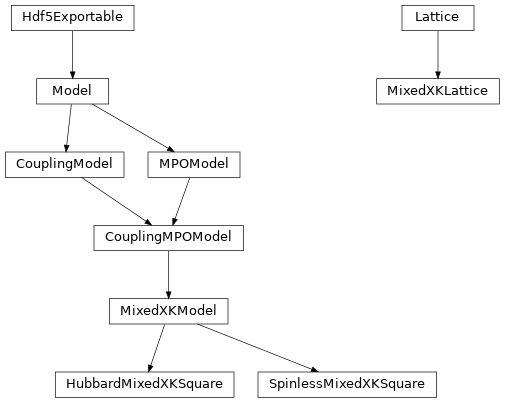mixed_xk
full name: tenpy.models.mixed_xk
parent module:
tenpy.modelstype: module
Classes

|
Example: Spin-full Hubbard model on a square lattice in x-k-Basis. |
|
Lattice for fermions with mixed real and momentum space on a cylinder. |
|
Base class for a Hamiltonian represented in mixed x-k-space on a cylinder. |
|
Spin-less fermionic Hubbard model on a square lattice in x-k-basis. |
Module description
Basic model for DMRG with mixed real- and momentum-space representation.
This module provides classes for DMRG of fermions in a mixed real- and momentum-space basis, as described in [motruk2016].
We consider infinite cylinders in real-space along the cylinder axis,
but transform to momentum space around the cylinder.
The DMRG unit cell consists of N_rings “rings” on the cylinder with a given x-coordinate i.
Inside each ring, we consider Ly repetitions of N_orb independent fermionic orbitals around
the cylinder. Each orbital is one fermionic state that can be occupied or empty and corresponds to
a unique creation/annihilation operator in second quantization.
We will also refer to the orbitals as “site”; they will be represented
by the 2-dimensional Hilbert space of a FermionSite.
The real-space operators \(c^{(\dagger)}_{i,j,l}\) are index by x-coordinate \(x = 0, ... , N_{rings}-1\) along the cylinder axis, y-coordinate \(y = 0, ..., L_y\) around the cylinder, and orbital \(l = 0, ... N_{orb}\). We transform them into momentum space with the convention (for all \(x,l\) independently):
We use the indices k = 0, ... Ly-1 and define the actual momentum as
\(k_y = 2 \pi i / L_y * k\) for \(k \leq Ly/2\) and
and shift to \(k_y = 2 \pi i * (k-L_y) / L_y ` for :math:`k > Ly/2\) such that
\(k_y \in (-\pi, \pi]\).
The momenta fulfill the usual relations
which transform the anti-commutation relations from real to momentum space and vice versa,
In the MixedXKLattice, we consider one ring in the cylinder as unit-cell of a 1D lattice,
since all of the ‘sites’ inside a ring need to have different charges if we conserve total k_y.
The unit-cell index u inside a ring is defined as \(u = k* N_{orb} + l\).
Methods for conversion are provided.
Note that the sites in the DMRG “snake” might be shuffled once more due to the
ring_order parameter, ultimately given in the lattice attribute
order.
The Jordan-Wigner strings follow the final DMRG snake.
Note
It is not obvious how to generalize this to (hard-core) bosons, since the lack of the Pauli exclusion principle implies a possibly large occupation on single k modes, i.e., hard-core bosons in x-y-space don’t map to hard-core bosons in x-k-space!